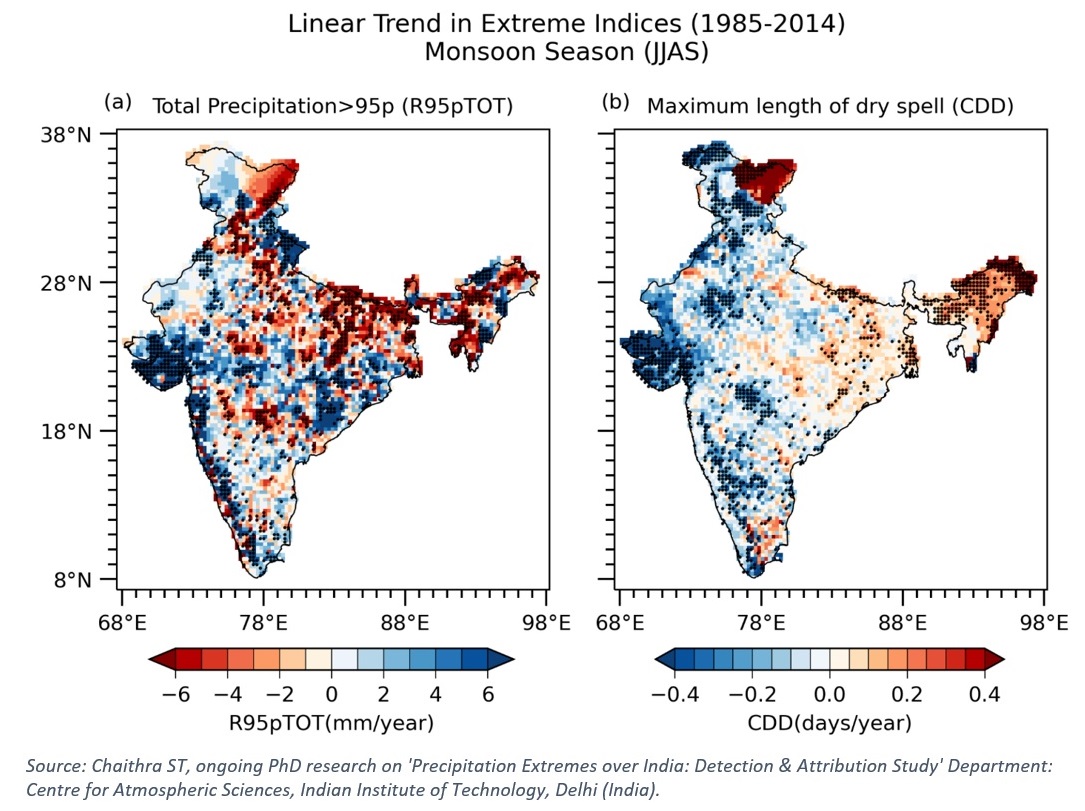By Chaithra ST, PhD Student, Indian Institute of Technology Delhi, India
Human activities, particularly greenhouse gas (GHG) emissions dominated by CO2, are the primary drivers of climate change, leading to rising global temperatures and changing weather patterns (IPCC 2021). While natural factors like the El-Niño-Southern Oscillation (ENSO) and volcanic activity also affect global mean temperatures, their impacts are smaller compared to human contributions (Fischer and Knutti 2015; Gillett et al. 2021). Human-induced climate change has increased the frequency, intensity, and duration of extreme weather events, necessitating better understanding, monitoring, and mitigation efforts (IPCC 2021).
Global surface temperatures have risen by 1.1°C above pre-industrial levels in 2011-2020, primarily due to GHG emissions, with ongoing increases driven by unsustainable energy use, land use, and consumption patterns (IPCC 2023). Rising temperatures have led to increased heatwaves and extreme heat events (Bindoff et al. 2014; Perkins-Kirkpatrick and Lewis 2020), while human influence on precipitation changes is less clear. Studies suggest increasing trends in extreme precipitation events globally, albeit with significant regional variability (Seneviratne et al. 2021). Extreme precipitation events are also increasing in various parts of India, leading to devastating floods in recent years, including the 2013 Uttarakhand, 2014 Srinagar, 2015 Chennai, 2017 Gujarat, 2018 Kerala, and 2023 Himalayan floods. These events caused significant human and economic losses, with rising trends in extreme rainfall intensity identified in various parts of India including central India, the Western Himalayas, and the upper Indus basin (Goswami et al. 2006; Mishra and Liu 2014; Roxy et al. 2017), highlighting the urgent need for climate change attribution studies.

India typically experiences its heaviest rainfall along the west coast, followed by the central and northeastern parts of the country. Recent observations suggest a noteworthy increase in extreme precipitation intensity (represented by the index ‘R95pTOT’ which is the total precipitation when rainfall > 95p) over the northwestern region, particularly Gujarat, from 1985 to 2014 (shown in the figure above). Concurrently, there has been a reduction in the maximum length of consecutive dry days (CDD) over the northwest indicating more frequent and intense rainfall events and fewer prolonged dry periods. Conversely, the northeastern regions have seen a decrease in extreme rainfall intensity and an increase in CDD implying a shift towards drier conditions.
In the twenty-first century, GHGs and aerosols are the primary anthropogenic forcing factors. However, aerosol levels are anticipated to decline (Lamarque et al. 2011; Wang et al. 2015) may amplify climate warming and exacerbate extreme weather events driven by GHGs (Rotstayn et al. 2013; Lin et al. 2018). Globally, anthropogenic GHG emissions have significantly contributed to the intensification of extreme precipitation events (Min et al. 2011; Madakumbura et al. 2021). The contribution is expected to rise nonlinearly with further temperature increases, reaching about 40per cent with a 2°C temperature rise (Fischer and Knutti 2015). Detecting human influence on regional extreme precipitation is challenging due to natural variability masking anthropogenic signals, although regional-scale detection of anthropogenic signals may occur earlier (Martel et al. 2018).
Evidence underscores changes in extreme precipitation patterns globally. With rising temperatures, the frequency and intensity of extreme weather events are projected to increase, posing significant challenges to human and natural systems. However, detecting human influence on regional extreme precipitation changes remains complex due to natural variability. Nonetheless, the urgency of understanding and mitigating the impacts of these changes cannot be overstated, particularly for a country like India. This highlights the need for concerted efforts in climate change attribution studies and the development of effective adaptation and mitigation strategies to address the growing risks posed by extreme events.
References:
Disclaimer: The views expressed in this piece are those of the author/s and do not necessarily reflect the views or policies of AIDMI.